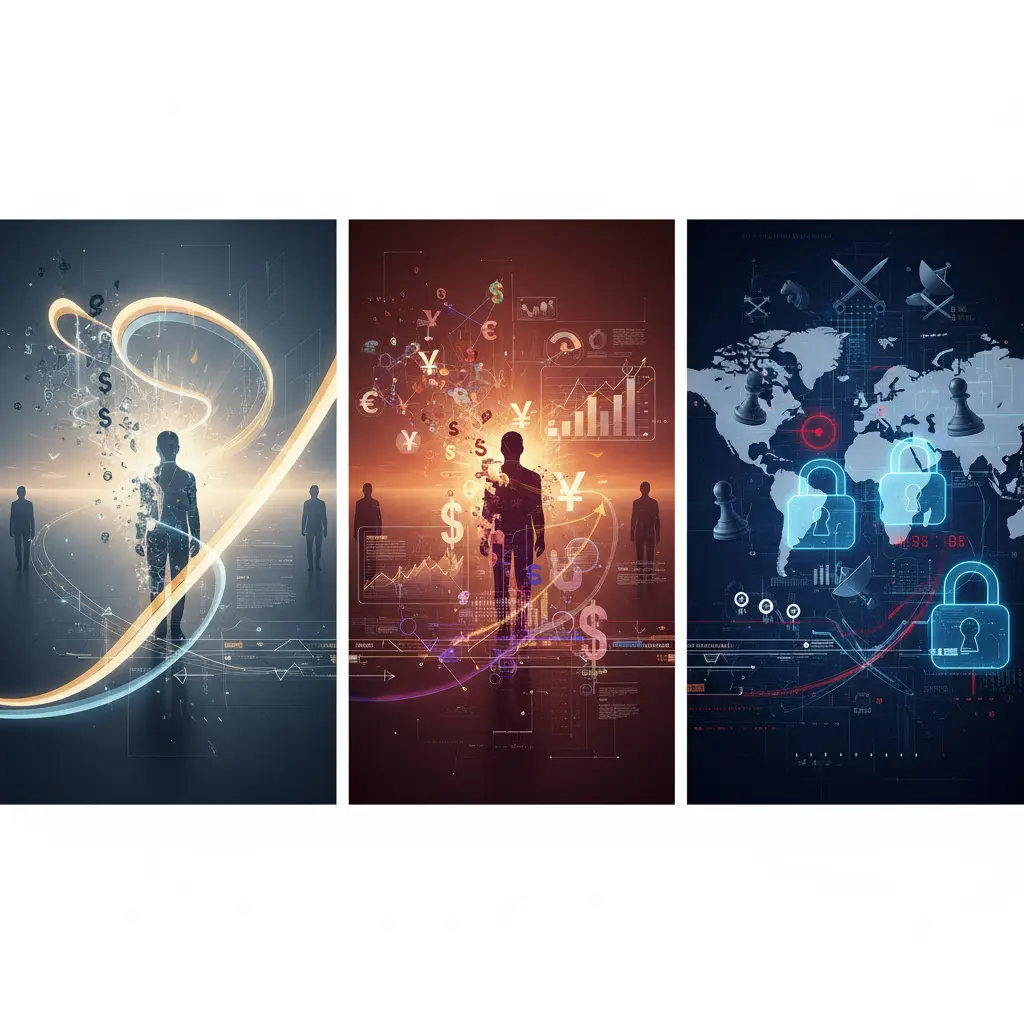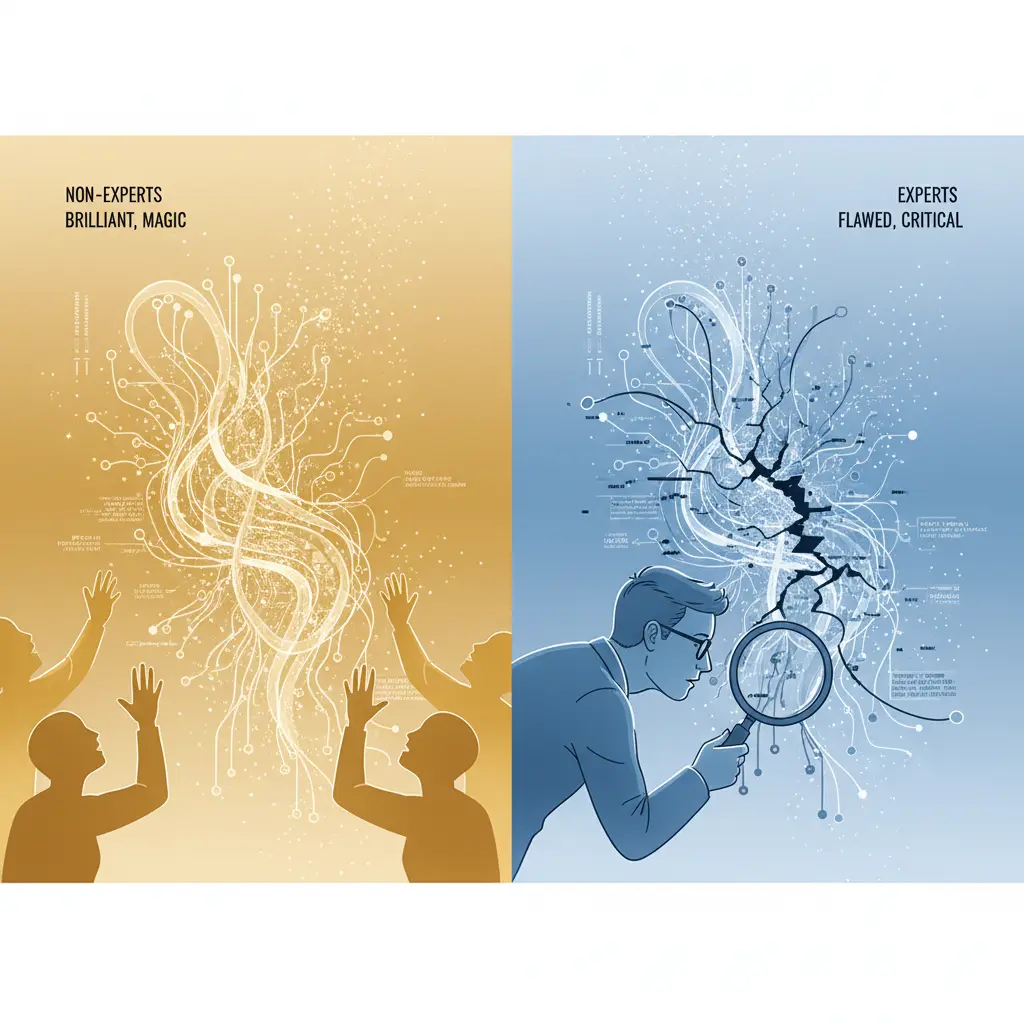Three Futures, One AI: Understanding Kurzweil, Mostaque, and Geopolitical Perspectives on Artificial Intelligence
Explore three critical perspectives on AI's future: Kurzweil's singularity vision, Mostaque's economic transformation, and urgent geopolitical realities.

Three Futures, One AI: Why All the Experts Are Right
You've probably noticed something odd about the AI conversation.
One expert tells you we're heading for a glorious merger with machines. Another says we've got about three years to fix the economy before it collapses. A third is warning about geopolitical tensions that could trigger conflict within months.
They can't all be right, can they?
Actually, they can. And understanding why might be the most important thing you do this year.
The Problem With Picking Sides
Here's what usually happens when you read about AI's future. You encounter one compelling vision. It makes sense. You adopt that perspective. Then you read another analysis that completely contradicts it, and suddenly you're confused about who to believe.
But what if these experts aren't disagreeing at all? What if they're just looking at completely different aspects of the same phenomenon through completely different telescopes?
Think of it like describing an elephant. One person touches the trunk and describes a snake. Another touches the leg and describes a tree. A third touches the tail and describes a rope. They're all describing the same animal, just from radically different vantage points.
That's what's happening with AI. And once you understand the three distinct vectors these experts are operating on, the confusion dissolves.
The Long Game: Kurzweil's Exponential Utopia
Ray Kurzweil has been predicting the Singularity for decades. His vision? Exponential technological progress leading to a fundamental transformation of what it means to be human.
In The Singularity is Near, Kurzweil isn't worried about next quarter's unemployment figures or geopolitical chess matches. He's tracking the ultimate destination of intelligence itself. He's asking: where does this technology take us when we follow the exponential curve all the way out?
His answer: human-AI merger. Not metaphorically. Literally. Intelligence explosion. Recursive self-improvement by AI systems. The compression of decades of progress into shorter and shorter timeframes. The end point? Curing diseases, extending human lifespan indefinitely, solving climate change, and fundamentally augmenting human cognition.
This is pure technology as religion. It's beautiful. It's inspiring. And it operates on a timeline measured in decades, not years.
What makes Kurzweil's perspective fascinating isn't whether his specific predictions pan out—his track record is mixed—but the framework he provides for thinking about ultimate outcomes. He's not concerned with the messy transition period. He's charting where the river flows if you follow it long enough.
That's a critically important lens. But it tells you almost nothing about navigating the rapids you're about to hit.
The Transition Period: Mostaque's Economic Reckoning
Emad Mostaque is thinking about something completely different. In The Last Economy, he's asking: what happens to society in the next three to ten years as AI becomes genuinely capable?
His timeline isn't decades. It's "thousands of days." That's roughly three years to a decade. And his concern isn't human-AI merger—it's making sure AI benefits the entire human population during the transition, without requiring merger.
Mostaque has identified something that should terrify you: the current economy was built for scarcity. Jobs provided income, identity, community, and purpose. AI threatens all four simultaneously.
Here's the kicker: capital no longer needs labour. AI is tax-deductible. Humans aren't. In AI-augmented teams, human labour value may actually turn negative. That's not hyperbole—that's the mathematical reality of the transition.
So Mostaque proposes a completely new framework: "Intelligent Economics" based on MIND capitals—Meaning, Intelligence, Network, and Diversity. He suggests giving everyone sovereign AI agents. Shifting from debt-based money creation to systems verified by human AI usage. Bitcoin-like currencies funding beneficial compute.
Whether these specific mechanisms work isn't the point. What makes Mostaque's perspective essential is the recognition that the transition period requires new economic systems, not just better technology. GDP is inadequate for measuring AI-era prosperity. Traditional economic models collapse when abundance replaces scarcity.
This is a fundamentally different question than Kurzweil's. It's not about ultimate technological potential. It's about surviving the societal upheaval between here and there.
And it still doesn't address the immediate crisis.
The Immediate Threat: Geopolitical Powder Keg
Now we get to the really uncomfortable part.
The AI 2027 blog and Leopold Aschenbrenner's Situational Awareness analysis aren't thinking decades out or even years out. They're thinking months out. And they're not focused on technology or economics—they're focused on national security and great power competition.
Their timeline? AGI by 2027. Potentially 2026. Based on concrete trends: 0.5 orders of magnitude per year in compute scaling, 0.5 orders of magnitude per year in algorithmic efficiency, and "unhobbling" gains as we move from chatbots to agents.
The evidence supporting this timeline is… uncomfortably strong. OpenAI's o3 model already scores in the 175th percentile among 150,000 competitive programmers. An undisclosed OpenAI model took second place at the AtCoder Heuristics World Finals. METR research shows AI autonomous task completion doubling every seven months.
But here's what makes this perspective distinct: the focus on what happens when AI becomes strategically decisive before we've figured out alignment, security, or coordination.
Aschenbrenner, a former OpenAI employee, argues that AI labs treat security as an "afterthought," essentially "handing secrets to the CCP." The AI 2027 project lays out month-by-month scenarios where China nationalizes AI research, steals state-of-the-art model weights, and the race dynamics push everyone toward increasingly risky development.
Their concern isn't the ultimate technological endpoint or the economic transition. It's the immediate geopolitical crisis: What happens when superintelligence provides decisive economic and military advantage? What happens when hundreds of millions of AGIs automate AI research and compress five-plus orders of magnitude of progress into one year or less?
The intelligence explosion Kurzweil envisions? These analysts think it happens fast—potentially within a year of reaching AGI. And they think we're catastrophically unprepared for the national security implications.
This perspective operates on a completely different vector than the other two. It's not asking "where do we end up?" or "how do we ensure broad benefit?" It's asking "how do we avoid catastrophic outcomes in the next 24 months?"
Why All Three Matter
So which expert is right?
All of them. Because they're not actually disagreeing.
Kurzweil is mapping the ultimate technological trajectory. Mostaque is designing transition mechanisms for societal upheaval. Aschenbrenner and the AI 2027 team are sounding alarms about immediate geopolitical risks.
These operate on different timelines: years versus decades. Different focal points: security versus economics versus technology. Different intervention points: policy versus systems design versus research direction.
You need the long view to understand where this ultimately leads. You need the transition focus to build systems that ensure broad benefit. You need the geopolitical lens to avoid catastrophic near-term outcomes.
Think of it as three nested timeframes:
Immediate (2025-2027): Geopolitical tensions, security concerns, race dynamics, potential for catastrophic outcomes from misaligned AGI or great power conflict.
Near-term (2025-2035): Economic transformation, labour market disruption, need for new monetary and social systems, transition from scarcity to abundance economics.
Long-term (2030-2070): Ultimate technological potential, human-AI integration, solving fundamental challenges like disease and climate, transformation of human existence.
All three timeframes are happening simultaneously. The immediate geopolitical crisis unfolds while the economic transition accelerates and the long-term technological trajectory continues.
Missing any one perspective leaves you blind to critical dynamics.
What This Means for You
If you're a business leader, you need all three lenses:
- The geopolitical lens tells you about regulatory changes, supply chain risks, and national security requirements that could hit in months.
- The economic lens tells you which business models survive the transition and how to position for an abundance economy.
- The technological lens tells you which capabilities become possible and where to place long-term bets.
If you're in government, these aren't competing priorities—they're complementary necessities. You simultaneously need security frameworks for the immediate crisis, economic policies for the transition, and research strategies for long-term outcomes.
And if you're just trying to understand what's coming? Stop looking for the "right" expert. Start recognizing that comprehensive understanding requires integrating all three perspectives.
The experts arguing about AI's future aren't wrong. They're just looking at different parts of the elephant. Kurzweil is describing the fully grown elephant in 20 years. Mostaque is describing how we feed the elephant during its turbulent adolescence. Aschenbrenner is describing the immediate danger of the elephant trampling everything in the next two years if we don't establish guardrails.
They're all describing the same elephant.
The Synthesis Nobody's Talking About
Here's what becomes visible when you overlay all three perspectives:
We're entering a period of maximum danger (geopolitical tensions, misalignment risks) coinciding with maximum disruption (economic transition, labour displacement) on the path toward maximum transformation (technological merger, abundance).
The next 2-5 years determine whether we navigate the danger. The next 5-15 years determine whether we manage the transition equitably. The next 20-50 years determine what we become.
These aren't separate challenges. They're nested phases of the same fundamental shift.
And understanding that shift requires holding all three timeframes in your head simultaneously. The immediate geopolitical crisis is real. The economic transition is real. The long-term technological transformation is real.
Dismissing any perspective as wrong misses the point entirely. They're operating on different vectors. They're all critically important. They're all potentially true.
The question isn't which expert to believe. It's whether you can develop the cognitive flexibility to believe all of them at once.
Where Do You Focus?
So what do you do with this information?
Start by recognizing that "when will AGI arrive?" is the wrong question. Better questions:
- What geopolitical tensions will emerge in the next 18 months? (Read Situational Awareness)
- What economic systems need building for the transition period? (Read The Last Economy)
- What technological capabilities become possible long-term? (Read The Singularity is Near)
The experts aren't confused. You were just expecting them to answer the same question. They're not. They're answering three different questions about the same phenomenon.
Kurzweil tells you where the river goes. Mostaque tells you how to build boats for the middle section. Aschenbrenner tells you about the waterfall immediately ahead.
You need all three maps. Because the territory includes all three features.
The real insight isn't picking the right perspective. It's recognizing that the complexity of what's ahead requires holding multiple perspectives simultaneously—even when they seem to contradict each other.
That's uncomfortable. Our brains want simple narratives. One timeline. One outcome. One expert who has it all figured out.
But reality doesn't care about our comfort. And AI's future is too complex for any single lens to capture.
So the next time you encounter an expert prediction about AI that seems to contradict something else you've read, ask yourself: are they actually disagreeing, or are they just looking at different timeframes and focusing on different aspects of the same transformation?
Because chances are, they're both right. Just about different parts of the elephant.
And understanding the whole elephant? That's the real challenge.
Key Takeaways
- Ray Kurzweil's long-term vision focuses on exponential technological progress, human-AI merger, and the ultimate transformation of human existence over decades.
- Emad Mostaque's transition framework addresses the immediate economic upheaval of the next 3-10 years, proposing new economic systems like "Intelligent Economics" based on MIND capitals.
- Geopolitical analyses from AI 2027 and Situational Awareness warn of immediate national security risks, with AGI potentially arriving by 2026-2027 amid great power competition.
- All three perspectives are valid because they operate on different timelines (immediate, near-term, long-term) and focus on different aspects (security, economics, technology).
- Comprehensive understanding requires integrating all three lenses rather than choosing one "correct" perspective.
Further Reading
- The Singularity is Near - Ray Kurzweil's vision of exponential technological progress
- The Last Economy - Emad Mostaque's framework for economic transition
- AI 2027 - Month-by-month scenarios of near-term AI development
- Situational Awareness - Leopold Aschenbrenner's geopolitical analysis
What aspect of AI's future concerns you most—the immediate geopolitical tensions, the economic transition, or the long-term technological transformation? And more importantly, do you have frameworks for thinking about all three?





